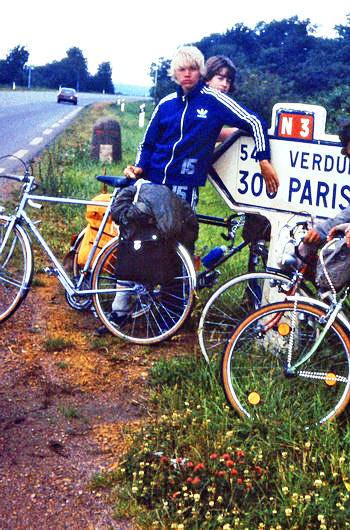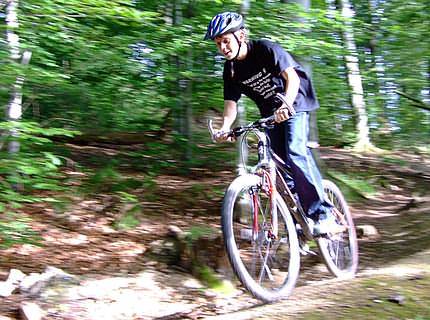source: www.youthwork-practice.com | 2000 Games, Devotions, Themes, Ideas and more for Youth Work
only for private using
Biking tours and rallies with the youth group
Outdoor activities in form of biking tours are and important aspect in experiential education. Nothing strengthens the team spirit of a group as much as joint activities in nature. Biking tours are on top of the popularity scale, because basically everyone can participate. It does not matter whether the group is planning a trip for the weekend or just plans a rally for a few hours in the afternoon. However, a word of caution, this adventure only can be successful if the youth workers observe some ground rules.
A bike ride at the weekend

Biking tours
©: www.youthwork-practice.com
Ideally, the bike tour is planned jointly between the youth worker, children and adolescents. Because if the group members are allowed to have a say on the destination, which route to choose and where to plan for breaks, then they learn, so to speak playfully, to take responsibility. These days there is a very well developed cycling network so that those biking tours are a safe adventure. It was not like that 25 years ago.
Optionally, before you start your tour, divide all participants into small groups according to their level of expertise. The reason is that when you go with larger groups the group or riders can stretch out for quite some length. If you divide the kids into smaller groups it also becomes easier to provide help if somebody has an accident or flat tyre.
At any time, the youth worker carries the responsibility of the supervisor. Therefore, he should ensure that competent people accompany the group to serve as additional supervisors. If the group is not bigger then 10-15 participants, you would probably be alright with two adults plus the youth worker. For larger groups you will need more adults. The person (adult) who carries the map and knows the route rides in front of the group while another adult rides at the end. Alternatively, these smaller groups can be put together by different kids of different age, where the older kids help you keep an eye on the younger children and maybe can help with a band aid until the last rider catches up.
Safety aspects
Safety is one of the factors contributing to a successful tour. Thus, youth worker and other supervisors are recommended to inspect all bikes as least one day before the tour to make sure they are all road worthy. In particularly check that the brakes and lights are working. If you are planning a longer trip, investing in saddlebags is recommended to carry food and other needed items. And last but not least, a helmet is part of every biking tour. A suitable bike of course is a prerequisite for the tour. With a BMX bike you can’t last for a longer trip. Every mountain bike should have a saddle and of course, a lighting system. When you plan your tour, but latest when you give flyers home for the parents you need to indicate those prerequisites. On the morning of departure, it is way too late to realize that only a well-equipped bike can participate.
Before your tour can hit the road, all participants need to be informed about the road rules and that consideration for each other is crucial. No racing, no heroic overtaking – particular not with the wider luggage rack. With all this additional weight the bike will respond slightly different than what the child is used to. And certainly no whizzing down of steep hills. Also important is to always count in the “silliness of others” and be prepared to recognize dangers early on.
The supervisors must react immediately, if somebody does not comply with these rules.
Bicycle rally as part of the youth group

Bicycle rally
©: www.youthwork-practice.com
Today almost every kid has a mountain bike and also would like to try it in a competition. Well prepared bike rallies offer themselves as the highlight of the annual program.
No matter how popular those bike rallies are they also pose some risks. In order to minimize those risks, you need to pay attention to a few things beforehand.
Selecting your rout
The person in charge should choose the safest possible route. That means: the terrain must not be too bumpy, too steep as well as rocks and stones should not pose as source for more danger.
Indicating possible danger
It is the responsibility of every youth worker to point out all potential risks and dangers to the participants. Ideally he could do so with the help of a rout map. Even better to take all participants slowly through the route before the event. It gives the contestants the chance to memorize the way. If necessary you can establish rules, for example, in particular bends there is no overtaking. For safety's sake you could put additional supervisors at strategic spots to monitor, that a) those rules are observed and b) he can assist quickly should an accident happen.
Safe bicycles
Before the race participants should be made aware of safety equipment. This includes at least the helmet. Anyone who has wrist- and knee pads can bring them along too. Nevertheless, it is the responsibility of the youth worker and all additional volunteers to make sure that the First Aid Kit is up to date and easily accessible.
Certificate and award ceremony
And of course after such a successful rally a certificate for the winner must not be missing. Templates, where you only have to fill in the name are available at office supplies or to download from the internet.
The following websites could be helpful:
-
A few thoughts on the subject: Bicycle tours and experiential education
-
Whoever is looking for other bike rallies or games involving bikes or scooters will find some in the section games for Bicycle Rallies & - Contests.
[ © www.youthwork-practice.com | 2000 Games and Ideas for Youth Work ]






